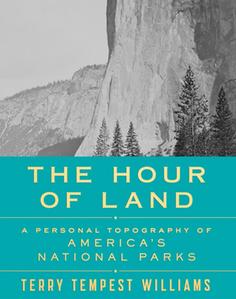
 Celebrated conservationist Terry Tempest Williams (Refuge; When Women Were Birds) commemorates the centennial of the U.S. National Park Service with The Hour of Land: A Personal Topography of America's National Parks. In 12 chapters, she explores 12 parks, their histories and futures. Ecology forms a natural overarching theme, but Williams's topics are variously personal, global and political. The places she visits range from Alaska to Maine to south Texas, while her subjects span still broader ground: biodiversity and water shortages; suicide and hopelessness; continuing unrest in U.S. relations with Native Americans; climate change; political prisoners from around the globe; and the legacy of the Civil War. Her writing is poetic, passionate and unexpected.
Celebrated conservationist Terry Tempest Williams (Refuge; When Women Were Birds) commemorates the centennial of the U.S. National Park Service with The Hour of Land: A Personal Topography of America's National Parks. In 12 chapters, she explores 12 parks, their histories and futures. Ecology forms a natural overarching theme, but Williams's topics are variously personal, global and political. The places she visits range from Alaska to Maine to south Texas, while her subjects span still broader ground: biodiversity and water shortages; suicide and hopelessness; continuing unrest in U.S. relations with Native Americans; climate change; political prisoners from around the globe; and the legacy of the Civil War. Her writing is poetic, passionate and unexpected.
In each chapter, Williams describes a visit to a specific national park, and then investigates the place and her experience there, sometimes directly through narrative storytelling and sometimes metaphorically. She begins with Grand Teton National Park, where her family has often returned over the decades and generations. The history of that park's founding and the establishment of the Parks system melds with her family story: "Our national parks are memory palaces where our personal histories reside." With her father, who spent his career laying pipe for industry and development, and a park superintendent, she tours Theodore Roosevelt National Park in North Dakota. Together they birdwatch and debate the balance between fossil fuel extraction and conservation. In Acadia National Park, Williams muses that parks may be "breathing spaces for a society that increasingly holds its breath." She finds Gettysburg National Battlefield representative of sustained resentments, pain and violence, and at Effigy Mounds National Monument, she encounters cultural heritage and controversy. To escape the pain of Gettysburg and Effigy Mounds, she heads into the desert, to Big Bend National Park.
Gates of the Arctic National Park in Alaska offers escape from a personal tragedy; Gulf Islands National Seashore, in Florida and Mississippi, reveals that the consequences of the Deepwater Horizon oil spill remain, stinking and stinging. Williams visits the exhibit by artist Ai Weiwei on Alcatraz Island in Golden Gate National Recreation Area; the recently established Cesar E. Chavez National Monument; and, of course, her home landscape of Canyonlands National Park in Utah. In Glacier National Park, where the Tempest family tries to celebrate a birthday by retracing old steps, they are instead nearly killed by in a forest fire that sweeps over the chalet where they lodge. In these travels, Williams finds beauty and distress over the future, and opines, "We continue to evolve and transform who we are in relationship to where we are."
By turns sad, despairing, and hopeful, even thrilled in the presence of natural beauty, The Hour of Land is emotive, intelligent and well traveled. It is only right that Williams should celebrate the Park Service's centennial with such a remarkable collection of wisdom and scintillating lines. --Julia Jenkins, librarian and blogger at pagesofjulia
Shelf Talker: In this phenomenal exploration of U.S. National Parks, Terry Tempest Williams turns her smart, poetic eye to place, history, ecology, the future and how we relate to one another.

